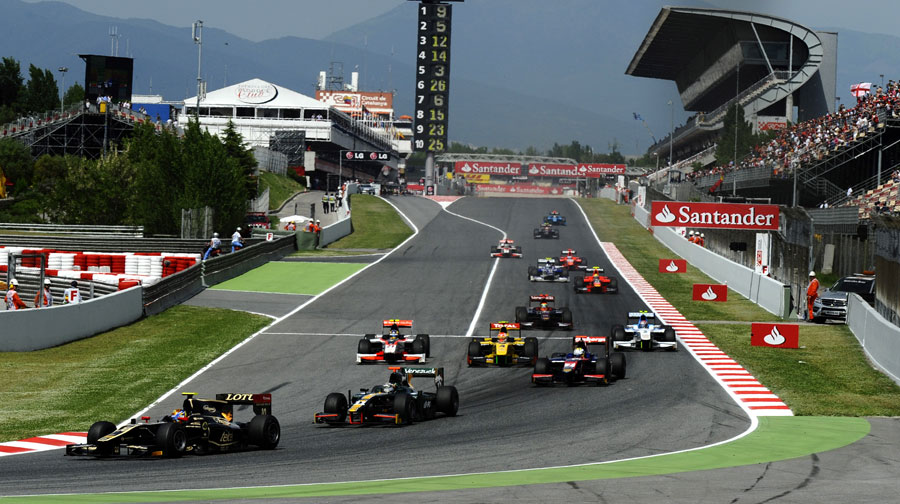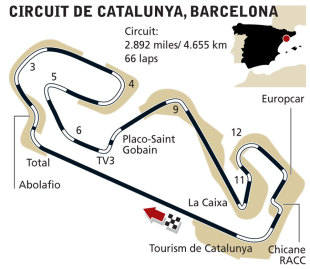GP2 driver Sam Bird gives his track guide to the Circuit de Catalunya ahead of this weekend's grand prix


Barcelona's Circuit de Catalunya has been a good hunting ground for me in previous years. I had a second place there last year in World Series by Renault and I've been on the podium there in GP2 as well. I also had a very good race there in my first ever GP2 race back in 2010 with ART, so it's a place that I have fond memories of and I'm hoping to add to them this weekend with a couple more trophies.
The track is a favourite for testing, especially in Formula One, and the wealth of data that's been built up there over the years does trickle down to GP2, especially now that the Pirelli tyres in GP2 are closer to those in F1. The way that you drive the car around this circuit is similar in both disciplines.
In the first two sectors you can really push and the tyres are still there, however in sector three the tyres start to overheat and degradation can start to creep in even after only one lap. So sector three is where a lot of people can lose a lot of time in qualifying. As for overtaking opportunities, I've found a niche market at turn five, but I suppose the most obvious places are turn one and turn ten.
Starting the lap, you have a slightly downhill braking zone into turn one and you brake after the 100 metre board. The thing is that you don't want to run wide on the exit of turn one because immediately you've got turn two, which goes back to the left, and immediately after that the long turn three. So if you get turn one wrong it's very difficult to get the next two corners right and a mistake can mess up the rest of that sector.
Turn three is a very high-energy, high-speed and long-lasting corner that takes a lot out of the tyres as they generate a lot of heat and take a lot of punishment through that corner. In GP2 nowadays you've always got to think about saving the tyres and, although you want to push on a qualifying lap, you've got to be thinking about what shape the tyres are going to be in in the final sector. In the race, for sure, your line through turn three is going to be slightly different to how it is in qualifying, because in qualifying you'll be able to use more of the track coming out of turn two and in the race you will set yourself up to leave more room on the exit of turn two. If you can open up the entry to turn three it really can help the tyres.
My line in turn four has also varied between qualifying and the race in previous years and it will be the same this weekend on the Pirelli rubber. In the past I have been able to make an undercut in turn four to overtake people into turn five, and that requires a lot of confidence under braking going into turn five. To be honest there is nothing that special about turns four and five, but I'm not going to reveal all my secrets of how I make my overtaking manoeuvres stick!
The next big corner is turn nine, which is a flat-out, high-speed and uphill right hander. You do not want to touch the kerb on the inside but you can take all the kerb on the exit and even a little bit of Astroturf as well. It's an enjoyable corner to drive.
Turn 10 can be an overtaking opportunity, but because you're braking at the 100 metre board you have to be quite close to really have a look. It's also fairly easy to defend by going to the inside so you usually struggle to make it stick unless you get a great run out of turn nine.
Towards the end of the circuit the last four or five corners on the track are all areas where you can break traction quite easily and overheat the rear tyres. That's an area where you really have to look after the tyres and if you put some effort into saving them in sectors one and two you will notice the difference. Since 2007 there has been a chicane ahead of the final corner but I would have loved to have tried the circuit when it had the high-speed penultimate corner. As it is we come out of the chicane and take the fast right hander onto the pit straight to start another lap.
Russian Time come to Barcelona off the back of a strong result in Bahrain but we are not deluding ourselves into believing that we have arrived. While we have made rapid progress since the first race in Malaysia, we're well aware that we still have a performance deficit compared to some of the other teams. This is to be expected; in this game, historical data is crucial and we are a new team. But we're all up the the challenge. Let's see what we can do.
Sam Bird writes for ESPNF1 ahead of each GP2 round
© ESPN Sports Media Ltd.
 Sam Bird writes for ESPNF1 after every World Series by Renault weekend Surrey-based Sam Bird made his name in Formula BMW before working his way through to GP2 where he raced for ART and iSport International. After a year fighting for the title in World Series by Renault he is now back in GP2 with RUSSIAN TIME alongside his duties as a Mercedes test driver
Sam Bird writes for ESPNF1 after every World Series by Renault weekend Surrey-based Sam Bird made his name in Formula BMW before working his way through to GP2 where he raced for ART and iSport International. After a year fighting for the title in World Series by Renault he is now back in GP2 with RUSSIAN TIME alongside his duties as a Mercedes test driver

